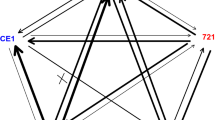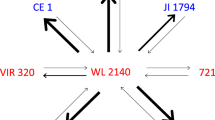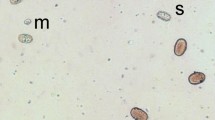Abstract
Reproductive barriers are thought to intensify with increasing genetic distance between species. To assess the extent of post-pollination reproductive isolation within and among the Asia Pacific species of Oryza series Sativae, crossing experiments using 15 accessions of O. meridionalis Ng, O. nivara Sharma et Shastry, and O. rufipogon Griff. were conducted. Intra- and interspecific crosses of the selfing species O. meridionalis and O. nivara had very low seed set and produced inviable F1 seeds indicative of strong pre- and post-zygotic barriers. Contrastingly, the outcrossing O. rufipogon exhibited high intraspecific crossability and modest compatibility with O. nivara and O. meridionalis in terms of seed set suggesting substantial pre-zygotic reproductive isolation of the species. O. rufipogon was asymmetrically compatible with O. meridionalis and symmetrically with O. nivara. The two inbreeding species manifested comparable degrees of isolation from O. rufipogon despite differences in strength of several post-zygotic barriers. Mating compatibility within and between the Asia Pacific species of Oryza series Sativae is not strongly spatially influenced, but some resistance to gene flow under sympatric conditions was observed. Intraspecific O. rufipogon F1s were more vegetatively robust and more late-flowering than their parents. Intra- and interspecific hybrids of Australasian O. rufipogon differed phenotypically from crosses with non-Australasian populations. Interspecific hybrids displayed both intermediate and parental character traits. O. nivara and O. rufipogon generated early-flowering F1s that are more similar to the former. O. meridionalis and O. rufipogon produced F1s that varied in phenology and morphology depending on the maternal and paternal species.






Similar content being viewed by others
References
Andersson S (1993) Morphometric differentiation, patterns of interfertility, and the genetic-basis of character evolution in Crepis tectorum (Asteraceae). Plant Syst Evol 184(1–2):27–40
Arnold ML (1997) Natural hybridization and evolution. Oxford University Press, Oxford
Banaticla-Hilario MCN (2012) An ecogeographic analysis of Oryza series Sativae in Asia and the Pacific. Ph. D. Thesis. Wageningen University, The Netherlands
Bomblies K, Lempe J, Epple P, Warthmann N, Lanz C, Dangl JL, Weigel D (2007) Autoimmune response as a mechanism for a Dobzhansky-Muller-type incompatibility syndrome in plants. PLoS Biol 5(9):e236
Duan S, Lu B, Li Z, Tong J, Kong J, Yao W, Li S, Zhu Y (2007) Phylogenetic analysis of AA-genome Oryza species (Poaceae) based on chloroplast, mitochondrial, and nuclear DNA sequences. Biochem Genet 45(1):113–129
Duistermaat H (1987) A revision of Oryza (Gramineae) in Malesia and Australia. Blumea 32:157–193
Ellstrand NC, Whitkus R, Rieseberg LH (1996) Distribution of spontaneous plant hybrids. Proc Natl Acad Sci USA 93:5090–5093
Favero AP, Simpson CE, Valls JFM, Vello NA (2006) Study of the evolution of cultivated peanut through crossability studies among Arachis ipaensis, A. duranensis, and A. hypogaea. Crop Sci 46:1546–1552
Fox J, Weisberg S (2011) An R companion to applied regression, 2nd edn. Sage, Thousand Oaks, CA
Fulton T, Chunwongse J, Tanksley S (1995) Microprep protocol for extraction of DNA from tomato and other herbaceous plants. Plant Mol Biol 13(3):207–209. doi:10.1007/bf02670897
Grundt HH, Kjolner S, Borgen L, Rieseberg LH, Brochmann C (2006) High biological species diversity in the arctic flora. Proc Natl Acad Sci USA 103(4):972–975. doi:10.1073/pnas.0510270103
Juliano AB, Naredo ME, Lu B-R, Jackson MT (2005) Genetic differentiation in Oryza meridionalis Ng based on molecular and crossability analyses. Genet Resour Crop Evol 52(4):435–445
Kairudin N, Benong M, Rahman N (1996) In situ and ex situ study on morphological traits of Oryza officinalis Wall. ex Watt. Second National Congress on Genetics, Malaysia: Genetics Society of Malaysia, 365–369
Kwon S-J, Lee JK, Hong S-W, Park Y-J, McNally KL, Kim N-S (2006) Genetic diversity and phylogenetic relationship in AA Oryza species as revealed by Rim2/Hipa CACTA transposon display. Genes Genet Syst 81(2):93–101
Li Z, Pinson S, Paterson AH, Park WD, Stansel JW (1997) Genetics of hybrid sterility and hybrid breakdown in an intersubspecific rice (Oryza sativa L.) population. Genetics 145(4):1139–1148
Lu BR, Naredo MEB, Juliano A, Jackson MT (2003) Genomic relationships of the AA genome oryza species. In: Khush GS, Brar DS, Hardy B (eds) Advances in rice genetics, vol 1. International Rice Research Institute, Los Baños (Philippines), pp 115–121
Mallet J (2005) Hybridization as an invasion of the genome. Trends Ecol Evol 10:229–237
Mallet J (2008) Hybridization, ecological races and the nature of species: empirical evidence for the ease of speciation. Philos Trans R Soc B Biol Sci 363:2971–2986
Marcussen T, Borgen L (2011) Species delimitation in the Ponto-Caucasian Viola sieheana complex, based on evidence from allozymes, morphology, ploidy levels, and crossing experiments. Plant Syst Evol 291(3):183–196. doi:10.1007/s00606-010-0377-z
Naredo MEB, Juliano AB, Lu BR, Jackson MT (1997) Hybridization of AA genome rice species from Asia and Australia.1. Crosses and development of hybrids. Genet Resour Crop Evol 44(1):17–23
Naredo MEB, Juliano AB, Lu BR, Jackson MT (1998) Taxonomic status of Oryza glumaepatula Steud. II. Hybridization between new world diploids and AA genome species from Asia and Australia. Genet Resour Crop Evol 45(3):205–214
Nezu M, Katayama TC, Kihara H (1960) Genetic study of the genus Oryza. Seiken Ziho 11:1–11
Ng NQ, Hawkes JG, Williams JT, Chang TT (1981) The recognition of a new species of rice (Oryza) from Australia. Bot J Linn Soc 82:327–330
Oka HI (1988) Origin of cultivated rice. Japan Science Society Press, Tokyo
Pellegrino G, Bellusci F, Musacchio A (2009) Genetic integrity of sympatric hybridising plant species: the case of Orchis italica and O. anthropophora. Plant Biol 11(3):434–441. doi:10.1111/j.1438-8677.2008.00135.x
R Development Core Team (2011) R: a language and environment for statistical computing. Austria, Vienna
Raimondi J, Sala R, Camadro E (2003) Crossability relationships among the wild diploid potato species Solanum kurtzianum, S. chacoense and S. ruiz-lealii from Argentina. Euphytica 132(3):287–295
Rieseberg LH, Carney SE (1998) Plant hybridization. New Phytol 140(4):599–624. doi:10.1046/j.1469-8137.1998.00315.x
Rieseberg LH, Willis JH (2007) Plant Speciation. Science 317(5840):910–914. doi:10.1126/science.1137729
Roschevics R (1931) A contribution to the study of rice. Trudy Prikl Bot Genet Selek 27(4):3–133
Stebbins GL (1959) The role of hybridization in evolution. Proc Am Philos Soc 103:231–251
Tateoka T (1963) Taxonomic studies of Oryza. III. Key to the species and their enumeration. Bot Mag Tokyo 76:165–173
Tiffin P, Olson S, Moyle LC (2001) Asymmetrical crossing barriers in angiosperms. Proc R Soc Lond B Biol Sci 268(1469):861–867. doi:10.1098/rspb.2000.1578
Vaughan DA, Morishima H (2003) Biosystematics of the genus Oryza. In: Smith WC (ed) Rice: origin, history, technology and production. Wiley, New Jersey, pp 27–65
Vaughan DA, Morishima H, Kadowaki K (2003) Diversity in the Oryza genus. Curr Opin Plant Biol 6(2):139–146
Vriesendorp B, Bakker FT (2005) Reconstructing patterns of reticulate evolution in angiosperms: what can we do? Taxon 54:593–604
Wang C, Tang S, Tang Y (1998) Effects of male sterile cytoplasm on yield and agronomic characters in Japonica hybrid rice, Oryza sativa L. Breed Sci 48:263–271
Waters DLE, Nock CJ, Ishikawa R, Rice N, Henry RJ (2012) Chloroplast genome sequence confirms distinctness of Australian and Asian wild rice. Ecol Evol 2(1):211–217
Wei C, Wang L, Yang Y, Chen Z, Shahid M, Li J, Liu X, Lu Y (2010) Identification of an S n5 allele in Oryza rufipogon Griff. and its effect on embryo sac fertility. Chin Sci Bull 55(13):1255–1262. doi:10.1007/s11434-010-0154-y
Widmer A, Lexer C, Cozzolino S (2009) Evolution of reproductive isolation in plants. Heredity 102(1):31–38
Wu C (2001) The genic view of the process of speciation. J Evol Biol 14:851–865
Xu JH, Kurata N, Akimoto M, Ohtsubo H, Ohtsubo E (2005) Identification and characterization of Australian wild rice strains of Oryza meridionalis and Oryza rufipogon by SINE insertion polymorphism. Genes Genet Syst 80:129–134
Yasumoto A, Yahara T (2006) Post-pollination reproductive isolation between diurnally and nocturnally flowering daylilies, Hemerocallis fulva and Hemerocallis citrina. J Plant Res 119(6):617–623
Yu L, Xu Q, Qiu B, Yz Xiong, Rao S (2007) Comparative studies on the main agronomic characteristics between in situ and ex-situ conserved wild rice populations in dongxiang. J Plant Genet Resour 8:99–101
Zheng X, Ge S (2010) Ecological divergence in the presence of gene flow in two closely related Oryza species (Oryza rufipogon and O. nivara). Mol Ecol 19:2439–2454
Zhu Q, Ge S (2005) Phylogenetic relationships among A-genome species of the genus Oryza revealed by intron sequences of four nuclear genes. New Phytol 167(1):249–265
Acknowledgments
This research was supported by the T.T. Chang Genetic Resources Center (TTC-GRC) in IRRI and the Biosystematics Group of Wageningen University. The authors acknowledge the use of services and facilities of TTC-GRC, IRRI. The wild rice nursery support staff lead by Ms. Ma. Socorro Almazan facilitated the crossing experiments and phenotyping of hybrids. The Genomic Diversity Laboratory team provided assistance in DNA extraction. Guidance in conducting crossing experiments, F1 screening and statistical analyses were provided by Ms. Ma. Elizabeth Naredo, Ms. Sheila Mae Mercado and Ms. Leilani Nora, respectively. Prof. Marc Sm. Sosef helped in editing the manuscript.
Author information
Authors and Affiliations
Corresponding author
Electronic supplementary material
Below is the link to the electronic supplementary material.
Rights and permissions
About this article
Cite this article
Banaticla-Hilario, M.C.N., McNally, K.L., van den Berg, R.G. et al. Crossability patterns within and among Oryza series Sativae species from Asia and Australia. Genet Resour Crop Evol 60, 1899–1914 (2013). https://doi.org/10.1007/s10722-013-9965-4
Received:
Accepted:
Published:
Issue Date:
DOI: https://doi.org/10.1007/s10722-013-9965-4




